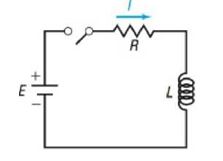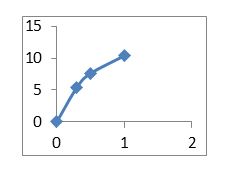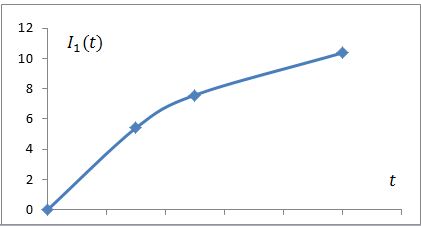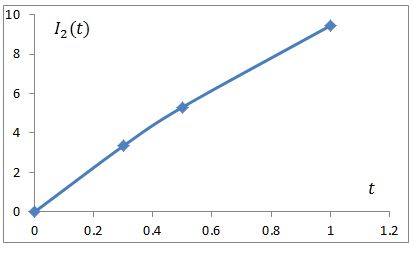
Concept explainers
119. Current in an RL Circuit The equation governing the amount of current I (in amperes) after time t (in seconds) in a single RL circuit consisting of a resistance R (in ohms), an inductance L (in henrys), and an electromotive force E (in voles) is

(a) If volts, ohms, and henrys, how much current I1 is flowing after 0.3 second? After 0.5 second? After 1 second?
(b) What is the maximum current?
(c) Graph this function (t), measuring I along the and t along the .
(d) If volts, ohms, and henrys, how much current I2 is flowing after 0.3 second? After 0.5 second? After 1 second?
(e) What is the maximum current?
(f) Graph the function on the same coordinate axes as .
To find:
a. If volts, ohms and henrys, how much current is flowing after second? After second? After 1 second?
Answer to Problem 113AYU
a. current is flowing after second, current is flowing after second, current is flowing after 1 second.
Explanation of Solution
Given:
Calculation:
a. and
How much current is flowing after second
How much current is flowing after second
How much current is flowing after 1 second
To find:
b. The maximum current.
Answer to Problem 113AYU
b. 12 maximum current when time approaches infinity.
Explanation of Solution
Given:
Calculation:
b. We obtain maximum current when time approaches infinity
To find:
c. Graph the function measuring along the and along the .
Answer to Problem 113AYU
c.

Explanation of Solution
Given:
Calculation:
c.

To find:
d. If volts, ohms, and henrys, how much current is flowing after second? After second? After 1 second?
Answer to Problem 113AYU
d. current is flowing after second, current is flowing after second, current is flowing after 1 second,
Explanation of Solution
Given:
Calculation:
d. and
How much current is flowing after second
How much current is flowing after second
How much current is flowing after 1 second
To find:
e. The maximum current.
Answer to Problem 113AYU
e. 24 maximum current when time approaches infinity.
Explanation of Solution
Given:
Calculation:
e. We obtain maximum current when time approaches infinity.
To find:
f. Graph the function measuring along the and along the .
Answer to Problem 113AYU
f.

Explanation of Solution
Given:
Calculation:
f.

Chapter 5 Solutions
Precalculus
Additional Math Textbook Solutions
Basic Business Statistics, Student Value Edition
Calculus: Early Transcendentals (2nd Edition)
Introductory Statistics
College Algebra with Modeling & Visualization (5th Edition)
Pre-Algebra Student Edition
Elementary Statistics: Picturing the World (7th Edition)
- Consider the function f(x) = x²-1. (a) Find the instantaneous rate of change of f(x) at x=1 using the definition of the derivative. Show all your steps clearly. (b) Sketch the graph of f(x) around x = 1. Draw the secant line passing through the points on the graph where x 1 and x-> 1+h (for a small positive value of h, illustrate conceptually). Then, draw the tangent line to the graph at x=1. Explain how the slope of the tangent line relates to the value you found in part (a). (c) In a few sentences, explain what the instantaneous rate of change of f(x) at x = 1 represents in the context of the graph of f(x). How does the rate of change of this function vary at different points?arrow_forward1. The graph of ƒ is given. Use the graph to evaluate each of the following values. If a value does not exist, state that fact. и (a) f'(-5) (b) f'(-3) (c) f'(0) (d) f'(5) 2. Find an equation of the tangent line to the graph of y = g(x) at x = 5 if g(5) = −3 and g'(5) = 4. - 3. If an equation of the tangent line to the graph of y = f(x) at the point where x 2 is y = 4x — 5, find ƒ(2) and f'(2).arrow_forwardDoes the series converge or divergearrow_forward
- Suppose that a particle moves along a straight line with velocity v (t) = 62t, where 0 < t <3 (v(t) in meters per second, t in seconds). Find the displacement d (t) at time t and the displacement up to t = 3. d(t) ds = ["v (s) da = { The displacement up to t = 3 is d(3)- meters.arrow_forwardLet f (x) = x², a 3, and b = = 4. Answer exactly. a. Find the average value fave of f between a and b. fave b. Find a point c where f (c) = fave. Enter only one of the possible values for c. c=arrow_forwardplease do Q3arrow_forward
- Use the properties of logarithms, given that In(2) = 0.6931 and In(3) = 1.0986, to approximate the logarithm. Use a calculator to confirm your approximations. (Round your answers to four decimal places.) (a) In(0.75) (b) In(24) (c) In(18) 1 (d) In ≈ 2 72arrow_forwardFind the indefinite integral. (Remember the constant of integration.) √tan(8x) tan(8x) sec²(8x) dxarrow_forwardFind the indefinite integral by making a change of variables. (Remember the constant of integration.) √(x+4) 4)√6-x dxarrow_forward
 Calculus: Early TranscendentalsCalculusISBN:9781285741550Author:James StewartPublisher:Cengage Learning
Calculus: Early TranscendentalsCalculusISBN:9781285741550Author:James StewartPublisher:Cengage Learning Thomas' Calculus (14th Edition)CalculusISBN:9780134438986Author:Joel R. Hass, Christopher E. Heil, Maurice D. WeirPublisher:PEARSON
Thomas' Calculus (14th Edition)CalculusISBN:9780134438986Author:Joel R. Hass, Christopher E. Heil, Maurice D. WeirPublisher:PEARSON Calculus: Early Transcendentals (3rd Edition)CalculusISBN:9780134763644Author:William L. Briggs, Lyle Cochran, Bernard Gillett, Eric SchulzPublisher:PEARSON
Calculus: Early Transcendentals (3rd Edition)CalculusISBN:9780134763644Author:William L. Briggs, Lyle Cochran, Bernard Gillett, Eric SchulzPublisher:PEARSON Calculus: Early TranscendentalsCalculusISBN:9781319050740Author:Jon Rogawski, Colin Adams, Robert FranzosaPublisher:W. H. Freeman
Calculus: Early TranscendentalsCalculusISBN:9781319050740Author:Jon Rogawski, Colin Adams, Robert FranzosaPublisher:W. H. Freeman
 Calculus: Early Transcendental FunctionsCalculusISBN:9781337552516Author:Ron Larson, Bruce H. EdwardsPublisher:Cengage Learning
Calculus: Early Transcendental FunctionsCalculusISBN:9781337552516Author:Ron Larson, Bruce H. EdwardsPublisher:Cengage Learning





